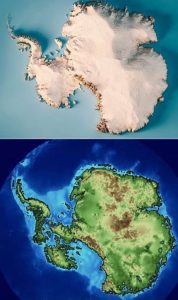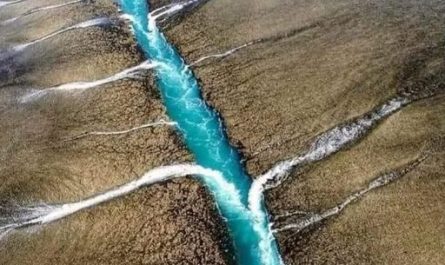Antarctica. The very name conjures images of a stark, white wilderness, a continent perpetually locked in a deep freeze, its colossal ice sheet seemingly an eternal fixture of our planet. But beneath this icy armor, a hidden history lies dormant, a past teeming with life and vibrant greenery that stands in stark contrast to the frozen desert we know today. Recent research, like that from Rice University in Houston, is peeling back the layers of ice and time, revealing an astonishing truth: millions of years ago, Antarctica was a lush, verdant land.

Imagine a world where the biting Antarctic winds carried the scent of pine and the ground was carpeted with ferns and mosses. The top panel of the accompanying image starkly presents the Antarctica of today – a seemingly endless expanse of white, sculpted by ice and snow. This is the continent buried under a colossal ice sheet, in some places nearly 5,000 meters thick, a landscape where temperatures rarely climb above freezing.
However, the bottom panel offers a breathtaking glimpse into a forgotten era. Stripped of its icy burden, the landmass reveals a tapestry of greens and browns, hinting at a landscape covered in vegetation, forests stretching across the terrain, and perhaps even winding rivers carving through the land. This isn’t a flight of fancy; this is the Antarctica that scientists are uncovering through meticulous research.
The key to unlocking this ancient secret lies buried beneath the ocean floor. In 2003, a dedicated team aboard a specialized icebreaker embarked on a remarkable mission: to drill deep into the sedimentary rock layers surrounding Antarctica. They retrieved cores stretching over 100 meters in length, precious geological archives that held microscopic clues to the continent’s past.
Within these ancient sediments, researchers discovered a treasure trove of preserved pollen grains. These tiny remnants of prehistoric plant life offered an unprecedented window into Antarctica’s long-lost ecosystems. The analysis of this pollen revealed a world where temperatures soared to a relatively balmy 10°C. Instead of the crushing weight of glaciers, vast coniferous forests thrived alongside open tundra, creating a habitat that would have been unrecognizable compared to the icy desolation of today.
Remarkably, the pollen found in these Antarctic cores bears a striking resemblance to plant species that still flourish in regions like New Zealand. This connection underscores the dramatic climate shift Antarctica has undergone over millions of years, a profound transformation from a green and vibrant landmass to the icy sentinel of the South Pole.
The side-by-side comparison in the image serves as a powerful visual reminder of Earth’s dynamic nature. Continents drift, climates change, and landscapes are sculpted by forces both immense and gradual. The story of Antarctica’s green past is a testament to this constant flux, a hidden chapter in our planet’s history waiting to be fully understood.
By studying the clues buried beneath the ice and the surrounding seas, scientists are piecing together a narrative of a warmer, greener Antarctica, offering invaluable insights into Earth’s climate history and the potential impacts of future environmental changes. The lost green past of Antarctica is not just a fascinating geological puzzle; it’s a crucial piece in understanding the long and ever-evolving story of our planet. The hidden histories beneath the ice, sand, and sea continue to surprise and inform us, reminding us that our Earth holds secrets that are still waiting to be unveiled.

